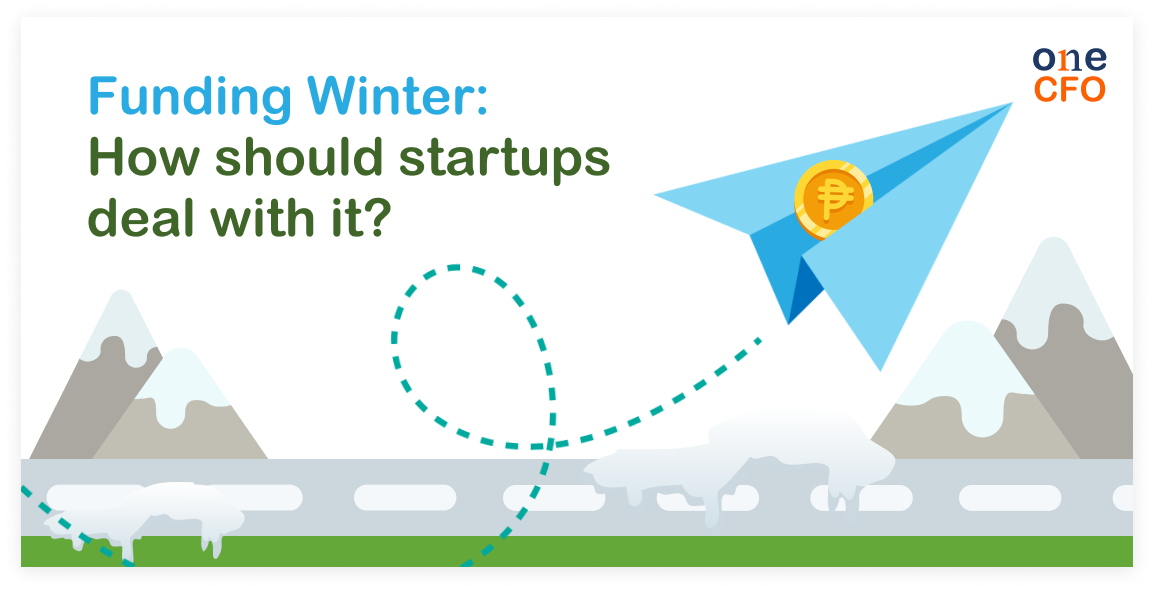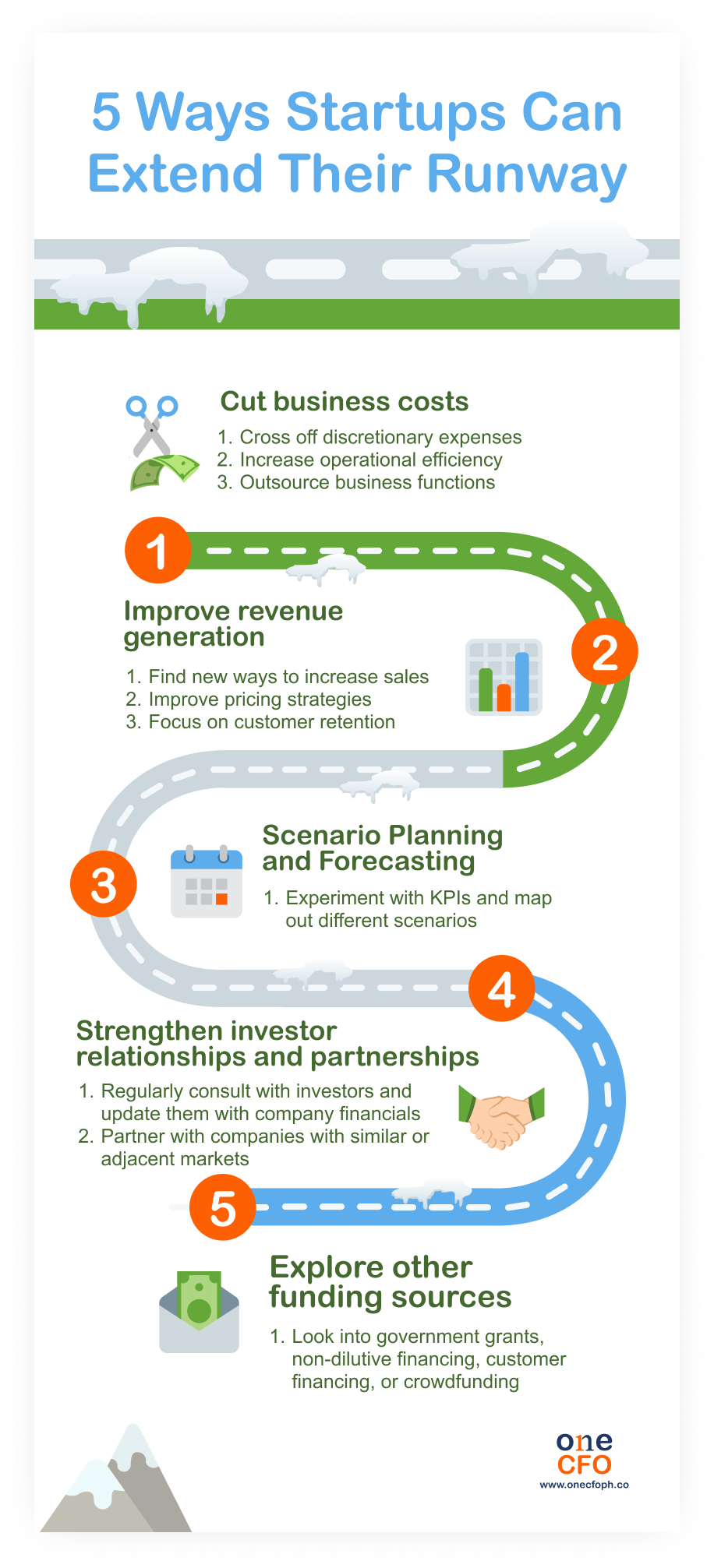
October 11, 2023 | 10:38 pm
Table of Contents
Many startups are experiencing a funding winter, where raising capital from investors
becomes more challenging. As funds start to dwindle, startup founders look for ways to
extend their runway for as long as possible and keep their companies afloat.
More than just a ticking clock, a company’s runway gives insight into its financial health
and alerts founders of the steps needed to keep the business running.
When fundraising is hard, startups can extend their runway in the following ways:
Read on to learn more about these tips so your startup can thrive this funding winter.
What is a funding winter?
Funding winter is the extended period when startups receive lower capital inflow from
investors than usual. Many companies will need help to raise funds during this time, which
poses a significant risk to their financial standing and valuation.
A report by Nikkei Asia states that as
of May 31, venture capitalist funding in Southeast
Asia plunged to the lowest level since the second half of 2019. There’s no telling how long
this downturn will last, so founders need to adapt while VC funding remains elusive.
Failure to manage the company’s resources during a funding winter can result in layoffs,
budget cuts, delays in product deployment, or worse, company wind-down. At this time, it’s
more critical than ever for founders to look for ways to extend their funds and survive the
funding winter.
What is a runway?
Runway is the number of months a business can keep
operating before running out of funds.
This metric is one of the most critical KPIs a startup should track.
Tracking the runway gives startups a clear view of their available cash and the time to
sustain operations. They can then make informed financial decisions and avoid running out of
funds prematurely.
At the very least, startups should have a runway of 12-18 months to give them ample time
to
create more revenue or secure another round of investments. Depending on your startup’s
stage, a longer runway will give you a more competitive edge as you have more time to
strategize, develop your product, and correct any mistakes.
How can startups extend their runway?
As venture capital funding becomes more challenging, startups seek ways to extend their
runway to survive.
Here are five steps to extend your runway:

Cut business costs
The first step in extending a company’s runway is to reduce its burn rate, which is how fast a business uses up or burns its money. Reducing cash burn means cutting business expenses, which a company can do in many ways.
Cross off discretionary expenses
First, founders should examine how they use their money and see what business costs they can
cut.
Companies should first cross out discretionary expenses since these are primarily costs that
companies can still operate without. Discretionary expenses include
travel or business
representation, marketing, company subscriptions, and additional employee perks.
Of course, it’s still essential that business owners carefully examine the ROI of the
expense they’re cutting. If a business cost like paid ads and influencer marketing can bring
more revenue, then it’s a necessary spend you should keep.
Increase operational efficiency
Another way to reduce business expenses is to review your current operations. The goal is to
boost company savings by streamlining or removing any bottlenecks in the business
processes.
Identify which tasks take a lot of time to finish and yet bring little value to the company.
It’s also essential to pinpoint repetitive activities that you can otherwise automate.
Examples of such tasks are bookkeeping, receivables management, and equity management, which
you can efficiently manage using software like Xero, Britana, and Carta.
Outsource business functions
When business owners become overwhelmed with tasks or deliverables, their first instinct is
to hire another employee. However, adding another staff to your payroll can easily affect
your runway, especially since you need to spend on additional salary, benefits, and
recruitment costs.
Instead of hiring a full-time employee, founders can outsource their business functions to
consultants or trusted service providers for a much lower price.
Outsourcing saves businesses money
since consultants typically work part-time or on a
project basis. What’s better is that the delivery of work is faster since they’re already
experts in the field.
For instance, you may outsource financial functions on a retainer or project basis:
Improve revenue generation
Cutting business expenses doesn’t mean founders should let their businesses hibernate or remain stagnant in earning money. Instead, increasing revenue while reducing costs is an effective way to extend a startup’s runway.
Find new ways to increase sales
When times are tough, it’s time for founders to put on their thinking hats and develop ways
to increase their sales.
Startups don’t need to spend money building new features, especially in a funding winter.
Instead, they should focus on analyzing and scaling their current product offering.
Market research: One of the things founders can do is
conduct
market research to identify if
there are any untapped adjacent markets they can cater to. This method will also help them
reposition or customize their product to widen their customer base. By doing so, the
business can diversify and won’t rely only on one customer base to earn.
Subscription models: If this applies to your business, you
can
explore shifting to
subscription-based models. This method provides a more predictable and steady income stream
than one-time sales.
Improve pricing strategies
Another way to increase revenue is by updating or modifying the business’s pricing strategies.
If you haven’t yet, you can explore using tiered pricing plans to cater to the market’s
varying levels of need or usage.
For service providers, providing options for contracts with shorter terms may help give more
flexibility to your clients. This strategy encourages more customers to try out the
business’s services before committing to a longer-term contract.
Reviewing all the pricing
factors affecting your current strategy is essential when changing
pricing models. Understanding these factors will help founders price their goods to reduce
any guesswork.
Focus on customer retention
Acquiring new customers is more complex and expensive (it can cost up to 7x more!) than
retaining new ones, which is why one of the main focuses of startups should be improving
customer retention.
When customers are less likely to spend during an economic downturn, building great
relationships with them and deeply understanding their behavior and pain points is more
important than ever.
Doing so can help founders upsell and cross-sell relevant and complementary products
suitable for the customers. Upselling and cross-selling will also significantly increase
your customer’s lifetime value (LTV) while retaining your current
customer acquisition cost
(CAC).
Scenario Planning and Forecasting
Besides being a good practice in business cash flow management, forecasting
plays a
significant role in preparing founders for challenges affecting their runways.
When forecasting, consider the best and worst-case liquidity scenarios and how the company
plans to address them. Each scenario gives founders a different picture of their revenue
goals and cash flows and helps startups prepare for crises.
Experimenting with KPIs such as CAC, LTV, the burn rate, and revenue run rate is also
essential. What do you do when your burn rate doubles? And what do you do when your LTV
remains the same?
Asking these questions beforehand and answering them through forecasting provides a better
picture of the business’s financial position.
In addition, constantly update your forecasts by matching the actual scenarios with the
projections. Forecasting means making statistical predictions of metrics like sales,
customer retention, and more for the next month, quarter, or even years.
Once this period comes and you record the actual data, you must compare the actual values
with the projected ones. Doing so will help startups evaluate their financial performance
and improve the accuracy of their following forecasts.
Strengthen investor relationships and partnerships
Even during a downturn, startup founders should pay attention to their relationships with
their current investors. Constantly consult with them and consider their opinions when
making decisions for the company.
Regularly updating them on your financials can boost investor confidence since you show
investors what the company has achieved over a certain period. These updates also show your
transparency and dedication as a founder.
Building strong relationships with investors helps startups gain fresh perspectives on
improving their products and extending their runway.
Moreover, your investors can open opportunities for the company to raise money by connecting
you with other investors - even during a funding winter. After all, business is sometimes
more about who you know, which means there are times when founders with better connections
have more funding opportunities.
Strategic partnerships
Creating partnerships with other companies
can also help reduce expenses, increase revenue,
and expand the business’s market reach. Look for companies that serve a similar or adjacent
market but with a complementary product offering.
When building more product features is out of the question due to limited funds, partnering
with these companies is better than competing. Forge partnerships through revenue-sharing
agreements, joint ventures, or co-marketing efforts to boost sales without significant
upfront costs.
Explore other funding sources
Raising funds from investors can be extremely challenging, so some founders choose to bootstrap or fund their businesses instead. But if you don’t have the resources to do so, there are still many ways startups can seek funding that doesn’t require venture capitalists!
Sources of startup funding
Diversifying and exploring other funding sources demonstrates a startup's adaptability.
Government grants: Look into government grants such as the
DICT Startup Grant Fund, where
early-stage startups in the Philippines can receive up to ₱5,000,000 of equity-free
capital.
Non-dilutive financing: Startup founders can also use
non-dilutive funding options that do
not require the startup to give up ownership or equity in the company.
Customer financing: Offer financing options to your
customers, allowing them to pay for your
product or service over time. This option boosts sales while providing a steady cash flow.
Crowdfunding: An effective way to secure funding for your
startup is through crowdfunding.
It involves raising funds from various individuals, referred to as the crowd. Crowdfunding
also offers a venue to validate your ideas and build a community of supporters.
How to thrive during a funding winter
Surviving the funding winter is about smartly managing your resources and finding creative
ways to extend your runway.
There is no single step in extending the company’s runway. Instead, founders should employ
different methods like reducing business expenses, increasing revenue, forecasting, building
relationships, and diversifying funding sources.
These steps involve researching, tracking KPIs, analyzing financial statements, and more. If
that sounds overwhelming, especially if you already have much on your plate, OneCFO can help
manage your runway!
OneCFO
is your partner for growth, providing you with CFO-level insights that guide
early-stage companies in navigating the startup world. With OneCFO, you can achieve
world-class finance function capabilities and benefit from our network of founders and
partners.
Visit us at onecfoph.co or contact us at [email protected] to
learn how we can boost your
startup success.
Read our disclaimer here.